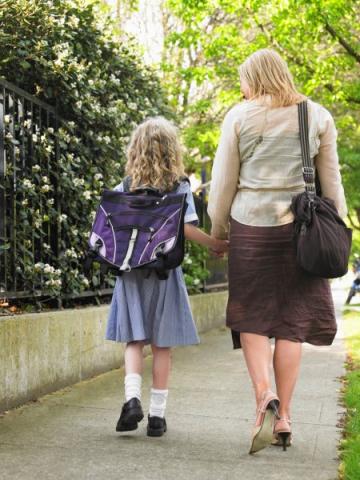Leave the car at home for the school run

With more than three-fifths of primary school pupils here being driven to school, the Public Health Agency (PHA) is encouraging parents to get their kids and themselves moving more by walking or cycling the school run.
61% of primary school pupils are driven to or from school by car, while less than a third – only 29% – walk. For post primary, 30% of pupils are driven by car and 18% walk.
Colette Brolly, the PHA lead on physical activity, said: “With the start of the new school term, it can be easy to fall back in to old habits and just jump in the car to drop the kids off at school. That’s why we’re challenging parents to leave the car at home and walk or cycle the school run and start to feel the benefits of an active start to the day.
“More than half – 55% – of primary school pupils live within a mile of their school so for many, it’s within fairly easy reach to complete a walk to and from home. If you live far away from the school and need to take the car, you can still make physical activity part of your journey by parking further away from the school gate and walk part of the way.
“It’s important that children are introduced to a culture of being active from an early age as it is something that will stay with them and benefit them throughout their lives. Make this a family experience, it won’t feel like exercise at all and you and your children will get to spend that special time together, as well as becoming more active.
“Being more active and having a healthy diet can have a positive impact for both adults and children. As well as helping maintain a healthy weight, it can also lift your mood and improve concentration which is great for kids in the classroom.
“Being physically active helps to build strong bones, muscles and a healthy heart, supports the development of social skills, and encourages a sense of wellbeing.”
The PHA, along with the Department for Infrastructure, funds the Active Schools Travel programme. The programme, delivered by Sustrans, encourages and supports pupils at more than 280 schools to walk, cycle or scoot to school rather than taking a lift in the car with their parents. The programme now also incorporates the Daily Mile, where pupils walk a mile together during the school day.
Children over the age of five years need to take part in moderate to vigorous intensity activities for at least 60 minutes, and up to several hours, every day. This can be broken up into small chunks of at least 10 minutes throughout the day – it all adds up.
For adults, walking at a brisk pace can make you feel good and reduce anxiety, can help you sleep better, and can reduce blood pressure, and with 65% of men and 57% of women being overweight or obese in Northern Ireland, walking to school with your children can also help you manage your weight.
For further information on the benefits of walking and tips and hints to get started visit the PHA’s website www.choosetolivebetter.com
Notes to editors:
- Statistics on travel to and from school 2015/16 can be found on the Department for Infrastructure website – https://www.infrastructure-ni.gov.uk/news/publication-method-travel-tofrom-school-by-pupils-northern-ireland-20152016
- Among post primary pupils, almost half (49%) travelled to/from school by bus as their main mode of transport and a further three tenths (30%) were driven by car. Just under a fifth (18%) of pupils walked to/from school while a small proportion took the train (1%). There has been no real change since 2014/15 (bus; 48%, car; 30%, walking; 19%, train; 1%).
- More than half (55%) of primary school pupils lived 0-1 mile from their school compared to just under a quarter (23%) of post primary school pupils. A similar proportion of primary and post primary pupils (26% and 22%) lived within 2–3 miles.
- Among primary school pupils, just over three fifths (61%) were driven to/from school by car and less than a third (29%) usually walked to/from school. One in 12 (8%) pupils travelled to/from school by bus, while no pupils cycled or took the train as their main mode of transport to and from school. These figures are around the same as in 2014/15 (car; 61%, walking; 29%, bus; 9%, bicycle; 1%, train; 0%).
- In contrast, more than half (55%) of post primary school pupils lived more than 4 miles from their school compared to 19% of primary school pupils.
- The Chief Medical Officer recommends that children over the age of five years need to take part in moderate to vigorous intensity activities for at least 60 minutes, and up to several hours, every day.
- The Chief Medical Officer recommends that adults take part in moderate to vigorous intensity activity for at least 150 minutes each week.
- You can find out more about the Active Schools Travel programme at https://www.sustrans.org.uk/northern-ireland/active-school-travel-northern-ireland
